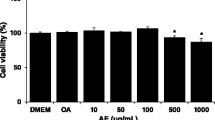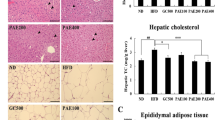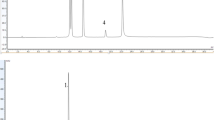Abstract
Diabetes is a chronic disease associated with triglyceride metabolism disorder, being an etiological factor in fatty liver disease, hypertension, and cardiovascular diseases. Diet-based therapy including energy balance and herbal supplements is a suitable approach to ameliorate progression of the disease. Leaves of Lippia triphylla (lemon verbena) from the family Verbenaceae are a foodstuff used as a tea drink or cooking seasoning, with confirmed safety during long-term use. We report herein the regulatory effect of L. triphylla extract (LTE) and its major compound acteoside (ACT) on abnormal liver lipid metabolism. Both LTE and ACT administration significantly decreased serum and hepatic lipid content, increased the phosphorylation level of the energy metabolism moderator adenosine 5′-monophosphate-activated protein kinase (AMPK), and reduced two major markers of lipid synthesis, viz. acetyl-CoA carboxylase (ACC) and fatty acid synthase (FAS), with an obvious enhancement in ACC phosphorylation. Furthermore, ACT promoted lipolysis and fatty acid oxidation by increasing messenger RNA (mRNA) expression of adipose triglyceride lipase (ATGL) and carnitine palmitoyltransferase (CPT)-1. These results provide scientific evidence for the development of functional foods containing L. triphylla extract and acteoside for treatment of diabetes-associated lipid metabolism disorder.







Similar content being viewed by others
References
Rotman Y, Sanyal AJ (2017) Current and upcoming pharmacotherapy for non-alcoholic fatty liver disease. Gut 66:180–190. https://doi.org/10.1136/gutjnl-2016-312431
Vijayaraghavan K (2010) Treatment of dyslipidemia in patients with type 2 diabetes. Lipids Health Dis 9:144. https://doi.org/10.1186/1476-511X-9-144
Saponaro C, Gaggini M, Gastaldelli A (2015) Nonalcoholic fatty liver disease and type 2 diabetes: common pathophysiologic mechanisms. Curr Diabetes Rep 15:607. https://doi.org/10.1007/s11892-015-0607-4
Mota M, Banini BA, Cazanave SC, Sanyal AJ (2016) Molecular mechanisms of lipotoxicity and glucotoxicity in nonalcoholic fatty liver disease. Metabolism 65:1049–1061. https://doi.org/10.1016/j.metabol.2016.02.014
Jing JC, Xiao JZ, Hong L (2018) Progress and challenges in the prevention and control of nonalcoholic fatty liver disease. Med Res Rev. https://doi.org/10.1002/med.21515
Haas JT, Francque S, Staels B (2016) Pathophysiology and mechanisms of nonalcoholic fatty liver disease. Annu Rev Physiol 78:181–205. https://doi.org/10.1146/annurev-physiol-021115-105331
Dake AW, Sora ND (2016) Diabetic dyslipidemia review: an update on current concepts and management guidelines of diabetic dyslipidemia. Am J Med Sci 351:361–365. https://doi.org/10.1016/j.amjms.2016.01.020
Ono M, Oda E, Tanaka T, Iida Y, Yamasaki T, Masuoka C, Ikeda T, Nohara T (2008) DPPH radical-scavenging effect on some constituents from the aerial parts of Lippia triphylla. J Nat Med 62:101–106. https://doi.org/10.1007/s11418-007-0197-9
Bahramsoltani R, Rostamiasrabadi P, Shahpiri Z, Marques AM, Rahimi R, Farzaei MH (2018) Aloysia citrodora palau (lemon verbena): a review of phytochemistry and pharmacology. J Ethnopharmacol 222:34–51. https://doi.org/10.1016/j.jep.2018.04.021
Buchwald-Werner S, Naka I, Wilhelm M, Schutz E, Schoen C, Reule C (2018) Effects of lemon verbena extract (recoverben(r)) supplementation on muscle strength and recovery after exhaustive exercise: a randomized, placebo-controlled trial. J Int Soc Sport Nutr 15:5. https://doi.org/10.1186/s12970-018-0208-0
Arthur H, Joubert E, De Beer D, Malherbe CJ, Witthuhn RC (2011) Phenylethanoid glycosides as major antioxidants in lippia multiflora herbal infusion and their stability during steam pasteurisation of plant material. Food Chem 127:581–588. https://doi.org/10.1016/j.foodchem.2011.01.044
Alipieva K, Korkina L, Orhan IE, Georgiev MI (2014) Verbascoside–a review of its occurrence, (bio)synthesis and pharmacological significance. Biotechnol Adv 32:1065–1076. https://doi.org/10.1016/j.biotechadv.2014.07.001
Zhang Y, Chen Y, Wang S, Dong Y, Wang T, Qu L, Li N, Wang T (2015) Bioactive constituents from the aerial parts of Lippia triphylla. Molecules 20:21946–21959. https://doi.org/10.3390/molecules201219814
Herranz-Lopez M, Barrajon-Catalan E, Segura-Carretero A, Menendez JA, Joven J, Micol V (2015) Lemon verbena (lippia citriodora) polyphenols alleviate obesity-related disturbances in hypertrophic adipocytes through AMPK-dependent mechanisms. Phytomedicine 22:605–614. https://doi.org/10.1016/j.phymed.2015.03.015
Chen Y, Liu M, Zhao T, Zhao B, Jia L, Zhu Y, Zhang B, Gao X, Li G, Li X, Xiang R, Han J, Duan Y (2014) Danhong injection inhibits the development of atherosclerosis in both Apoe(−)/(−) and Ldlr(−)/(−) mice. J Cardiovasc Pharmacol 63:441–452. https://doi.org/10.1097/FJC.0000000000000067
Li J, Liu M, Yu H, Wang W, Han L, Chen Q, Ruan J, Wen S, Zhang Y, Wang T (2018) Mangiferin improves hepatic lipid metabolism mainly through its metabolite-norathyriol by modulating Sirt-1/AMPK/SREBP-1c signaling. Front Pharmacol. https://doi.org/10.3389/fphar.2018.00201
Zhang Y, Liu X, Han L, Gao X, Liu E, Wang T (2013) Regulation of lipid and glucose homeostasis by mango tree leaf extract is mediated by AMPK and PI3K/AKT signaling pathways. Food Chem 141:2896–2905. https://doi.org/10.1016/j.foodchem.2013.05.121
Smith BW, Adams LA (2011) Nonalcoholic fatty liver disease and diabetes mellitus: pathogenesis and treatment. Nat Rev Endocrinol 7:456–465. https://doi.org/10.1038/nrendo.2011.72
Rinella ME, Sanyal AJ (2016) Management of NAFLD: a stage-based approach. Nat Rev Gastroenterol Hepatol 13:196–205. https://doi.org/10.1038/nrgastro.2016.3
Chen Q, Wang T, Li J, Wang S, Qiu F, Yu HY, Zhang Y, Wang T (2017) Effects of natural products on fructose-induced nonalcoholic fatty liver disease (NAFLD). Nutrients. https://doi.org/10.3390/nu9020096
Carling D, Viollet B (2015) Beyond energy homeostasis: the expanding role of AMP-activated protein kinase in regulating metabolism. Cell Metab 21:799–804. https://doi.org/10.1016/j.cmet.2015.05.005
Viollet B, Lantier L, Devin-Leclerc J, Hebrard S, Amouyal C, Mounier R, Foretz M, Andreelli F (2009) Targeting the AMPK pathway for the treatment of type 2 diabetes. Front Biosci 14:3380–3400 PMID: 19273282
Serviddio G, Bellanti F, Vendemiale G (2013) Free radical biology for medicine: learning from nonalcoholic fatty liver disease. Free Radical Biol Med 65:952–968. https://doi.org/10.1016/j.freeradbiomed.2013.08.174
Qian C, Meng L, Hai Y, Jian L, Si W, Yi Z, Feng Q, Tao W (2018) Scutellaria baicalensis regulates FFA metabolism to ameliorate NAFLD through the AMPK-mediated SREBP signaling pathway. J Nat Med 72:655–666. https://doi.org/10.1007/s11418-018-1199-5
Lyu M, Wang YF, Fan GW, Wang XY, Xu SY, Zhu Y (2017) Balancing herbal medicine and functional food for prevention and treatment of cardiometabolic diseases through modulating gut microbiota. Front Microbiol 8:2146. https://doi.org/10.3389/fmicb.2017.02146
Acknowledgements
This research was supported by the National Natural Science Foundation of China (81673703) and the Important Drug Development Fund, Ministry of Science and Technology of China (2018ZX09735-002).
Author information
Authors and Affiliations
Corresponding author
Additional information
Publisher's Note
Springer Nature remains neutral with regard to jurisdictional claims in published maps and institutional affiliations.
Rights and permissions
About this article
Cite this article
Zhang, Y., Liu, M., Chen, Q. et al. Leaves of Lippia triphylla improve hepatic lipid metabolism via activating AMPK to regulate lipid synthesis and degradation. J Nat Med 73, 707–716 (2019). https://doi.org/10.1007/s11418-019-01316-5
Received:
Accepted:
Published:
Issue Date:
DOI: https://doi.org/10.1007/s11418-019-01316-5




